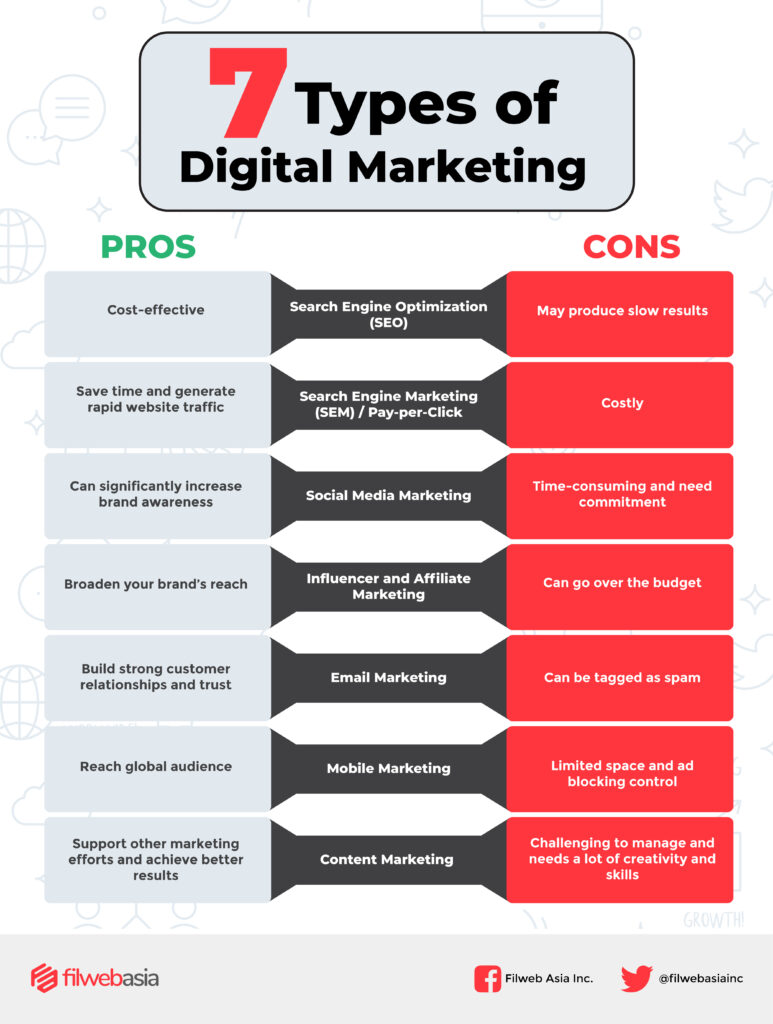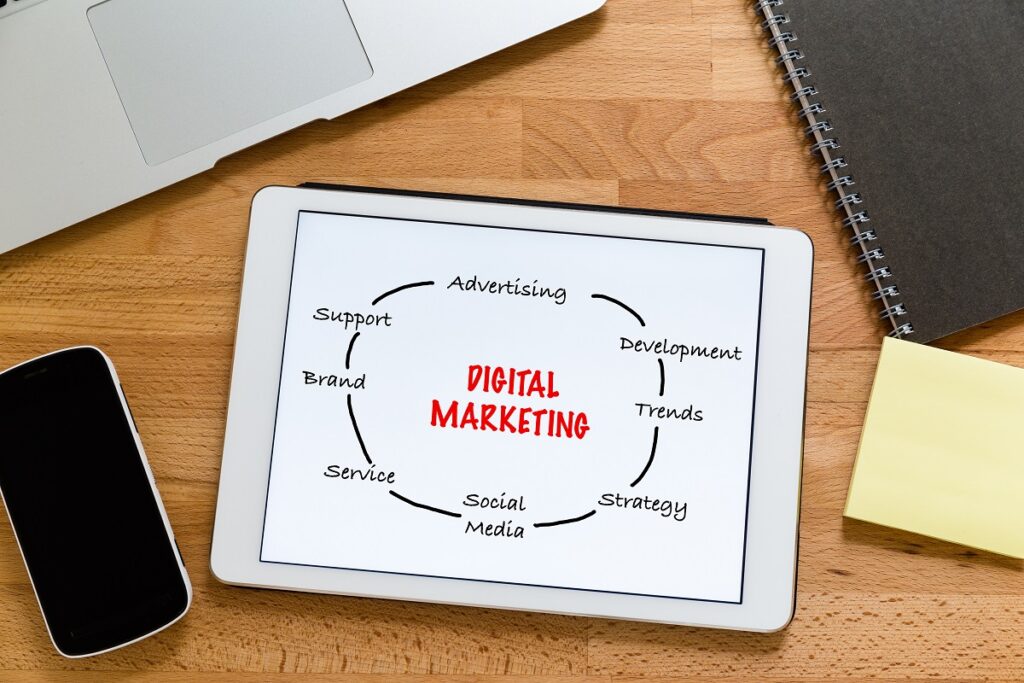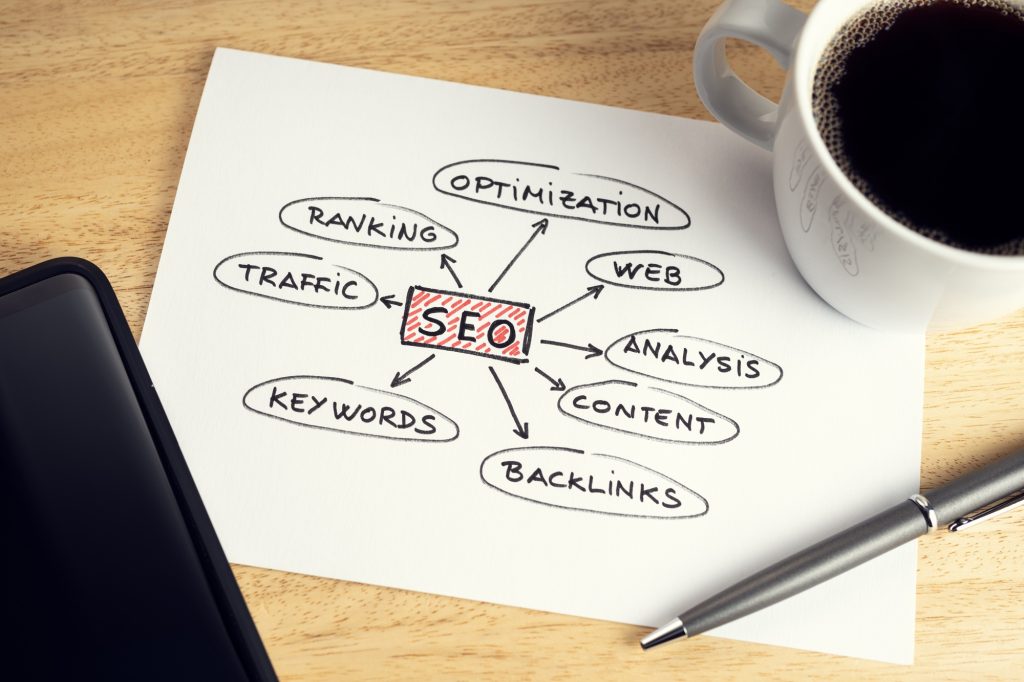When we wake up, we check our phones first. It is a technology that keeps us connected to our loved ones through the internet, making it impossible to live without. As a result, the undeniable power of digital tools and platforms is obvious. This couldn’t be any truer as businesses aim to make the most of these tools to reach a wide range of people and rank at the top of search engines.
Digital marketing is now one of the most essential strategic approaches for companies. People use the internet to get information about their purchases. Using various digital marketing methods to advertise brands and products allows businesses to contact their target audience through channels that they are already using.
Before we dive into the different types of digital marketing, let’s first define what digital marketing is.
What is Digital Marketing?
Digital marketing refers to any marketing initiative that makes use of online media and the internet via linked devices such as mobile phones, home computers, or the Internet of Things (IoT). Today, digital marketing focuses on contacting a consumer with conversion-oriented communications across many platforms as they progress down the sales funnel. Marketing teams will track the contribution that each of these messages and/or channels plays in achieving their ultimate aim of gaining a customer.
Importance of Digital Marketing
Since 2015, marketing experts have reported spending more of their budgets on digital marketing strategies, while decreasing spending on traditional marketing sources. This is because of the rising presence of consumers on online channels, which provides businesses with additional options to reach their ideal customers all day, every day.
Here are a few more reasons digital marketing can benefit your company:

1. You can target only the prospects who are most likely to buy your goods or service.
You have little control over who sees your advertisement if you place it on TV, in a magazine, or on a billboard. Of course, certain factors may be measured, such as the magazine’s usual audience or the demographic of a certain neighborhood, but it’s still mostly a guessing game.
With tailored and high-converting marketing communications, digital marketing helps you to identify and target a very specific audience.
2. It is cost-effective than traditional marketing strategies.
Digital marketing allows you to track day-to-day campaign performance so you know which channels are doing well and which aren’t. This, in turn, allows you to optimize campaign spending for maximum return on investment (ROI). Traditional forms of advertising are not the same. It makes no difference how well your billboard performs—it still costs the same even if it does not convert.
Also, you have complete control over where you spend your budget with digital marketing. Instead of spending on PPC advertisements, you may invest in design software to create high-converting Instagram content. A digital marketing strategy enables you to shift in real time, ensuring that you never waste money on channels that are ineffective.
3. Digital marketing levels the playing field in your sector and enables you to compete with larger brands.
If you work for a small firm, you may find it challenging to compete with the major companies in your field, many of which have millions of dollars to invest in marketing campaigns. Fortunately, clever digital marketing campaigns provide a lot of opportunity to outrank the major businesses.
4. Digital marketing is measurable.
Digital marketing, unlike most offline marketing programs, allows marketers to observe exact outcomes in real time. If you’ve ever placed an ad in a newspaper, you know how tough it is to determine how many people flipped to that page and read it. There’s no way to determine for sure if that ad handled any sales at all.
5. A digital marketing plan is simpler to adapt and adjust.
The ability to adjust your plan is a significant advantage of digital marketing. Developing a digital marketing plan is far easier than developing a traditional marketing strategy, such as mailers or billboard advertising. For example, if an online ad isn’t performing as intended, you can change or halt it to improve outcomes.
6. Digital marketing can boost your conversion rate and lead quality.
Being able to measure the effectiveness of each technique helps in the development of stronger strategies. Improving your tactics increases your conversion rate. Investing in online marketing guarantees everything is optimized for maximum conversions.
Likewise, not all leads are equal in terms of value to your company. Digital marketing enables you to target a specific audience, resulting in higher-quality leads who are more likely to become customers. Connecting your company with the most valuable leads can enhance your conversion rate.
7. With digital marketing, you can engage audiences at every level.
Online channels enable you to track your consumers’ entire purchasing cycle. Understanding and evaluating how customers move and function is critical for converting leads. You can track them along the process using digital marketing. Even if they do not convert in the early stages, it ensures they have created a connection with your company.

Types of Digital Marketing
There are many types of digital marketing you can use to expand your audience’s reach. Using several digital marketing platforms can assist you in developing a well-rounded campaign that will produce the optimal outcomes.
Here are seven of the most effective digital marketing strategies to assist you decide which ones would work best for your company:

Download Seven Types of Digital Marketing infographics here.
1. Search Engine Optimization (SEO)
SEO is a digital marketing approach that aims to claim and maintain a website’s top spot on the Search Engine Results Page, or SERP. For example, when you Google something, you’re given with a page full of links that are sorted according to their relevance to your search; this is known as search engine results page (SERP). To use SEO, you must first understand the keywords that the audience you want to attract is searching for. Then you must create content based on these terms.
Pros: This approach is completely free. Also, when your brand appears in organic search results, it appears to your customers to be more ‘genuine’ and objective.
Cons: You may not have to pay particularly for search results, but it does take time and effort to generate outstanding content and optimize your website technically. You are at the mercy of Google’s ever-changing algorithms, and with all the information available today, ranking high in organic results is quite difficult.
2. Search Engine Marketing (SEM)/ Pay-per-Click
Search engine marketing, or SEM, refers to paid advertisements that show at the top of SERPs. The cost of these advertisements is often determined by the number of clicks the link receives, hence the term “pay-per-click.”
When you pay for these top SERP positions, the label “Ad” will appear next to your URL. Despite the fact that consumers are aware that these are ads, many still click on these links, and it may be a very effective digital marketing strategy.
Pros: It speeds up the process of reaching the top rank and is time efficient.
Cons: This type of digital marketing can be expensive to target popular keywords. Also, most individuals nowadays are distrustful of adverts in search results and prefer to rely on natural search results.
3. Social Media Marketing
Social media platforms are utilized as a digital marketing tool in social media marketing. You can purchase ads to reach a new audience, or you can build a profile for your company on any social networking platform and post about new items, sales, or newly published content. The type of audience you wish to attract will determine the social media site you utilize.
Pros: As others like, comment on, and share your work, your efforts will quickly multiply. Facebook/Instagram advertisements enable you to target particular client categories and reach the correct people.
Cons: Social media is complex. The algorithm is modified on a regular basis, and alongside this come new content types that are also released regularly. You’ll have to check for updates constantly. Although posting on social media appears to be straightforward, it requires strategic planning and commitment to do it regularly and efficiently.
4. Influencer and Affiliate Marketing
Working with an affiliate or influencer can help you reach more people by engaging their existing audience. Try to work with someone who is well known and respected in your field for an effective influencer relationship. They can develop material to promote your company or product, as well as offer a link to your website. The influencer will be compensated every time a sale is completed, or a link is clicked.
Pros: First and foremost, you gain access to the influencer’s existing following. So, you don’t have to wait to construct one yourself. Moreover, working with a well-known figure allows you to gain solid followers and customers.
Cons: It is not simply about paying a lot of money to work with influencers. You must choose the ideal partner depending on your audience and business, and then find authentic methods to collaborate with them. The distrust of influencers is growing; thus, you must be cautious and upfront when paying them for promotions.
5. Email Marketing
Invite people who visit your website or business to join an email subscriber list. You may send emails about sales, special events, or product releases with their approval. The most significant aspect of this digital marketing channel is that it adds value to your audience’s journey. Offer them exclusives they won’t find anywhere else, and you’ll be able to develop a mutually advantageous connection that will boost brand loyalty.
Pros: Maintaining frequent communication with your email list allows you to strengthen relationships, and they are more likely to remember you when they are ready to buy.
Cons: Customers frequently do not open emails. Therefore, it becomes challenging to identify ways to offer value in order to keep customers from unsubscribing.
6. Mobile Marketing
Mobile marketing is a way to do marketing through SMS. Sending marketing messages by SMS and push notifications is a tested approach to capturing the recipient’s attention, especially since over 90% of such communications are opened right away.
Pros: Customers nowadays spend more time on their mobile phones than on their desktops/laptops. This makes mobile marketing a feasible digital marketing strategy, since the materials reach them where they spend most their time.
Cons: Compared to computers, the space is limited. When people are communicating, they dislike being interrupted by marketing messages.
7. Content Marketing
Blog entries, how-to videos, and other instructional resources are examples of content marketing. This sort of marketing allows you to engage with your audience and answer their inquiries. It can also help create leads and close transactions.
Content should be published regularly with the intended audience in mind. Your brand would become a trusted voice in the industry by generating high-quality, dependable content. You want your audience to come to you first for information on the newest industry trends.
Pros: Content is a very flexible option. It gives you the chance to promote your brand by educating, entertaining, and motivating your audience. Plus, it fuels all other sorts of digital marketing and is completely free.
Cons: The market is very competitive, and ranking organically for desired keywords takes a long time. To be effective, consistency and good quality are required. Your content must suit the needs of your customers while also branding and reaching your business goals.

Outsource Digital Marketing Services to FilWeb Asia, Inc.
Following digital marketing trends can be risky. Nonetheless, you must not pass up opportunities. It’s a good thing that types of digital marketing such as SEO, search engine marketing, social media marketing, and content writing have made this possible. If you’re not a marketing expert, outsource the difficult duties to experienced digital marketers.
Learn and experiment with the most recent digital marketing strategies and trends to ensure your success. FilWeb Asia, Inc. is the ideal choice if you need help to grow your business using the latest trends. Contact us today!









